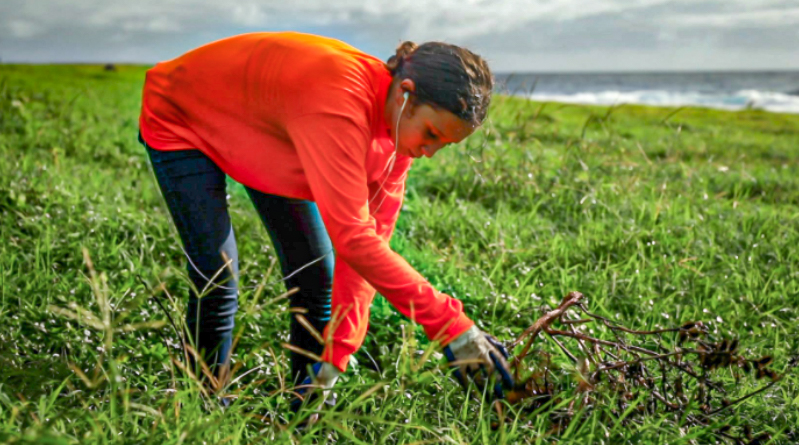Public Virtual Presentation: 7 Environmental Projects Funded Through Maui CARES
With unemployment at record levels due to COVID-19, Maui County followed the Great Depression-era Civilian Conservation Corps’ model that put 3 million people to work. The County used federal CARES Act funding to put more than 70 Maui and Molokai residents to work in November for seven local conservation nonprofits.
The residents provided needed labor that benefited the coral reefs, cultural resources and the environment.
The public is invited to a free presentation about the projects on Wednesday, Jan. 27 at 5:30 pm on Zoom. It’s free, but registration is required. To sign up, visit http://bit.ly/mauiCARES.
The presentation will detail this unique collaborative employment and workforce training program and the impact it had on the local environment. It will include videos, photos and firsthand accounts of the projects and accomplishments, with information on how the projects incorporated traditional Hawaiian cultural practices and modern technology to prevent sediment pollution in the ocean and protect valuable cultural resources.
The County of Maui Office of Economic Development’s Maui CARES created the program, which was funded by the Federal CARES (Coronavirus Aid, relief and Economic Security) Act.
Maui Nui Marine Resource Council served as the fiscal sponsor, overseeing the administration of the Maui CARES funding for the projects and managing the rapid employment of more than 70 new hires with the help of simplicityHR by ALTRES.
The workers participated in conservation and restoration projects in Olowalu, Waihe’e, Keanae, Kipahulu, Hana and Moloka’i. All projects were rooted in Hawaiian cultural practices and values that serve as the foundation of the community. Their work was filmed by Inflatable Film of Kula. The evening will include video premieres exclusively for webinar attendees.
“Through this presentation, attendees will be immersed in a virtual experience to feel the importance of Kuleana, ʻOhana, Kōkua, Aloha ʻAina, Mālama ʻAina and Hānai ʻAina,” said Ekolu Lindsey, President of Maui Cultural Lands and a principal organizer of this program. “Be inspired to follow in the footsteps of those who have come before us, as we share our legacies with you.”
The participating nonprofits included:
- Ka Honua Momona on Molokai worked to restore two ancient fishponds, which will help trap sediment before it reaches the open ocean – with the benefit of also producing fish for local people.
- Kipahulu ‘Ohana in East Maui improved a lo’i (wetland taro farm). The taro plants will slow the flow of stormwater, allowing time for sediment in the water to settle, rather than flow out to sea.
- Hawaiian Islands Land Trust in Waihe’e worked to remove invasive species along 3,900 linear feet of Kalepa Stream to lower sediment loads in the nearshore waters off Waihe’e and protect nearshore coral reefs.
- Ke Ao Hali‘i (KAH) in Hana worked on 27 acres of publicly owned land at Mokae/Kaholaiki and another 2 acres of contiguous land, directly above Hamoa Beach. The project included invasive plant removal and native habitat restoration for seabirds and insects, and a biological survey of ‘opihi as a baseline for a possible ‘opihi rest area in the future.
- Kipuka Olowalu in West Maui reestablished washed out and damaged lo’i (taro fields), rebuilt vanished lo’i and prepared lo’i for planting in the Olowalu Cultural Reserve. Workers removed overgrowth, fire hazards and invasive plants; planted native plants and crops; and repaired infrastructure.
- Na Moku ‘Aupuni O Ko‘olau Hui in East Maui focused on land and shoreline management on a county parcel leased to Nā Mamo O Mū’olea for 50 years. It included removal of invasive plants around a rock wall that is on the historic registry; preparation for wall restorations; maintenance of two heiau (sacred Hawaiian site) on the property; installation of new fencing around an area designated for native trees and medicinal plants; and maintenance and repair of feral animal controls.
- Na Mamo o Mu‘olea in East Maui worked in the Hana Moku, Mu‘olea ahupua‘a on watershed management and stream maintenance. It also conducted stream and ditch monitoring in the East Maui Irrigation system to establish accurate data for stream and ditch flow and loss as a basis for making sound future management decisions related to this resource and delivery infrastructure.
“This presentation is a celebration of all that was accomplished and learned,” Lindsey said. “We encourage the public to attend to connect with these organizations and the workers who put heart and soul into these challenging and impactful projects.“
The emcees for this event are Ekolu Lindsey and Darla Palmer-Ellingson, local radio show host of the public affairs program, Island Environment 360, Maui’s only commercially broadcast public affairs show on environmental and related Hawaiian cultural topics, aired on the stations of H-Hawaii Media.

















